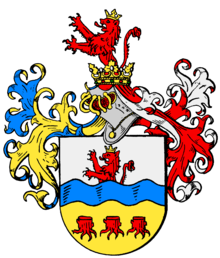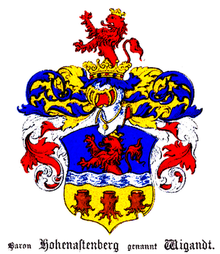Hohenastenberg called Wigandt
Hohenastenberg called Wigandt is the family name of the German-Baltic barons who had lived in the former Old Livonia since the middle of the 15th century . They originally came from Hesse and were enrolled in the nobility registers of the Courland knighthood in 1620 . In 1862, the Imperial Russian Senate recognized the noble name Hohenastenberg-Wiegandt with the title of baron.
History and lineage
A Johann Wiegandt was the first of this family who came to Old Livonia in 1418 and was in the service of the Teutonic Order . In the church of Hofzumberge Castle there is a memorial for the administrators Alexander von Hohenastenberg Vigandt († 1640) and Tomas von Hohenastenberg Vigandt. Johann von Hohenastenberg called Wigandt († 1478) came to Old Livonia in 1418 ⚭ Elisabeth von Sobbe
- Christopher von Hohenastenberg called Wigandt († 1623) ⚭ Agnata von Franck (* around 1621)
- Johannes Nikolaus von Hohenastenberg called Wigandt, Oberhauptmann zu Tuckum ⚭ Anna von der Recke (1634–1696)
- Heinrich von Hohenastenberg called Wigandt (1634–1700), Polish captain ⚭ 1) Anna von Berg († 1706), 2) Margarethe von Brunnow († 1667)
- Johann Moritz Adolph von Hohenastenberg called Wigandt (1674–1773) ⚭ Maria von Plattenberg
- Johann Heinrich von Hohenastenberg called Wigandt (1703–1767) ⚭ Maria von Trotta called Treyden
- Moritz Adolph von Hohenastenberg called Wigandt (1731–1766) ⚭ Maria Gertrud von Bistram († 1818)
- Moritz Otto Heinrich von Hohenastenberg called Wigandt (1766–1835) ⚭ Christina von Grotthus (1784–1835)
- Julius Alexander Moritz von Hohenastenberg called Wigandt (1820–1873) ⚭ Helene von Hahn (* 1825, † 1912 in Berlin)
- Gustav Theodor Emil Moritz von Hohenastenberg called Wigandt (* 1860, † 1936 in Berlin)
- Julius Alexander Moritz von Hohenastenberg called Wigandt (1820–1873) ⚭ Helene von Hahn (* 1825, † 1912 in Berlin)
- Moritz Otto Heinrich von Hohenastenberg called Wigandt (1766–1835) ⚭ Christina von Grotthus (1784–1835)
- Moritz Adolph von Hohenastenberg called Wigandt (1731–1766) ⚭ Maria Gertrud von Bistram († 1818)
- Johann Heinrich von Hohenastenberg called Wigandt (1703–1767) ⚭ Maria von Trotta called Treyden
- Johann Moritz Adolph von Hohenastenberg called Wigandt (1674–1773) ⚭ Maria von Plattenberg
Possessions
In the New Kurländische Güter-Chroniken family members of the von Hohenastenberg named Wigandt are named as owners, tenants or buyers of the manor Dursuppen:
- 1590 The heiress Christina von Altenbockum , descendant of Peter von Altenbockum married to Barthold von Hohenastenberg called Wigandt.
- In 1846 the owner of Dursuppen's inheritance, Charlotte von Heyking , b. von Brunnow signed a preliminary contract for the sale of the Dursuppen estate with Rittmeister Baron Gustav von Hohenastenberg called Wigandt.
- 1847 Dursuppen on the basis of the advance contract with the Rittmeister Gustav Baron von Hohenastenberg called Wigandt. For years he was a member of the Courland genealogists commission. (* 1812) ⚭ Klara Freiin von Fircks (1820–1849). He had two sons Heinrich Ludwig Theodor (* 1846) and Donatus Carl Georg (1849–1873).
- In 1873 Gustav von Hohenasten-Wigandt sold the Dursuppen estate to his son Heinrich. Prince Carl Lieven and Heinrich von Hohenasten called Wigandt change the course of the border.
- In 1883 Gustav von Hohenastenberg, known as Wigandt, died and Heinrich bequeathed the Dursuppen estate.
- In 1899 Baron Heinrich Wigandt sold his estate Dursuppen to Baron Woldemar von Boenninghausen called Budberg .
coat of arms
- In escutcheon a red golden-crowned, of a cross-flowing current , rising out Leo , with red proposed tongue, in a blue shields. In the golden base there are three torn, short trunks torn from each other and torn from branches. The lion bursts out repeatedly on the gold-crowned helmet . The helmet cover is lined with gold from the top to the middle and silver at the bottom, the gold with blue, the silver with red.
- The blazon in the GHdA : Divided by a blue wavy bar, above a growing gold crowned red lion in silver, below in gold three uprooted red tree stumps next to each other. On the helmet with blue-gold-red-silver covers the growing lion.
General
In the village of Dierfeld ( Vulkaneifel ) there is a cemetery of the von Hohenastenberg family. Not far from the estate, surrounded by a beech hedge, is the small cemetery with a wooden cross and graves arranged on the side. The cemetery site is not open to the public
The writer Karl Robert wrote the novel Hohenastenberg in two volumes . Novel from married life
literature
- August Wilhelm Hupel , New Nordic Miscellanees , volumes 13-14, Verlag Johann Friedrich Hartknoch, Riga 1796, pp. 417-419
- Genealogisches Handbuch des Adels , Adelslexikon Volume V, Volume 84 of the complete series, CA Starke Verlag, Limburg (Lahn) 1984, ISSN 0435-2408 , pp. 293-294
Web links
- Baron von Hoenastenberg, called Viganti
- 63. Von Hohenastenberg called Wiegandt List of names of all Courland and Semgallian enrolled Adel, 1st class . In: August Wilhelm Hupel, Statistical-Topographical News from the Duchies of Courland and Semigallia . Along with other shorter essays, Riga , Johann Friedrich Hartknoch, Riga 1785.
Individual evidence
- ↑ Find A Grave, database and pictures [1] Memorial site for Alexander von Hohenastenberg Wigandt (unknown – 1640), Find-A-Grave-Gedenkstätten-Nr. 183584412
- ↑ History of the Lords of the Recke (1878), Constantin Graf von der Recke-Volmerstein, p. 331 ( digitized version ).
- ↑ 3. Berg, 1) Christina Anna Ursula Berg, von Carmel, p. 24 , In: August Wilhelm Hupel, Der nordischen Miscellaneen 1. – 28 pieces: materials for an öselschen nobility story, Verlag v. Hirschheydt, 1790.
- ^ List of members of the society in 1876, full members 1876, April 2nd Gustaf Baron Hohenastenberg-Wigandt, in Mitau. In: Report of the meeting of the Courland Society for Literature and Art from 1876 ( PDF ).
- ^ New Courland Goods Chronicles. According to the Guts-Briefladen and other sources, edited and on behalf of the Courland Knighthood Comités, Eduard Freiherr von Fircks, knight archivist. Mitau 1900.
- ↑ Courland goods documents No. 305-307 and 311, Herder Institute for Historical Research on East Central Europe, Institute of the Leibniz Association ( Courland goods documents ).
- ^ Blazon of the family coat of arms. In: August Wilhelm Hupel, Neue nordische miscellaneen, volumes 13-14, Verlag Johann Friedrich Hartknoch, Riga 1796, p. 418.
- ↑ Data sources Georg Dehio : Handbook of German Art Monuments: Rhineland-Palatinate , Saarland , 1984, Deutscher Kunstverlag [2]
- ↑ High Astenberg: A Novel from the married life. By Karl Robert, 1861, published by Adolph Büchting ( digitized version ).


